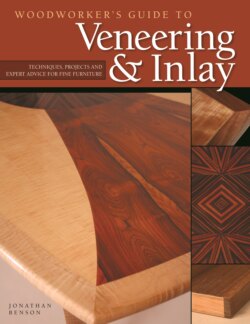Читать книгу Woodworker's Guide to Veneering & Inlay (SC) - Jonathan Benson - Страница 21
На сайте Литреса книга снята с продажи.
Storing veneers
ОглавлениеVeneer usually arrives rolled tightly in a box. Rolling helps protect veneer during transit and shipping, but it should be stored flat. Most distributors store veneer in a humidity-controlled environment, which means it dries out when exposed to the normal atmosphere of the average shop. If the veneer is allowed to dry out when it is still rolled up, it will tend to hold that shape. Because veneer arrives while it is still slightly moist, it is easy to unroll without cracking and splitting. I store my veneer sheets on long shelves spaced 8" to 12" apart, high up and out of the way in my shop (Figure 2-17). The shelves are above the level of the doors and windows to prevent wind gusts from catching the veneer. A few cheap shelf brackets will hold the shelves up because they do not carry a lot of weight. The veneer usually comes wrapped in brown paper, which I place on top of each pile and between each species, to keep them clean, and, more importantly, away from sunlight to prevent fading. Scrap plywood on top of the stack of paper and veneer on each shelf further protects the veneer from any wind.
After unrolling the veneers, number the sheets in one corner with pencil or chalk (Figure 2-18). Numbering will allow you to create perfect matches later on, no matter how mixed up your sheets become. Number any time you acquire multiple sheets of veneer. If you plan on storing the veneer for any length of time, tape the ends across the width with veneer tape or high-quality masking tape the day it arrives, before it can dry out at all. Taping the ends prevents splits that otherwise could easily travel the entire length of a sheet (Figure 2-19).
Check each sheet for defects (Figure 2-20). In addition to looking for lines from a chipped knife or tear out from a dull knife, see if each sheet is intact and in order. Sometimes improperly cut sheets can be hiding in the middle of a pile. Defects to look for include sheets that got folded over (a defect nearly impossible to fix), partial sheets, or sheets that are too thick or too thin in some areas. Also, closely examine the grain pattern, as out-of-order sheets could have been inserted into the stack, or the pattern could have changed over to another flitch. The defects rarely are attempts to cover mistakes by the manufacturer. The knife simply cuts so fast, and the process moves so much material at high speed, that close inspection of each sheet at every step is nearly impossible.
Figure 2-17. Veneers should be stored on flat shelves. The author stores veneers high in his small workshop to save floor space.
Figure 2-18. Sheets of veneer should be numbered to keep them in order. (Use a white pencil on dark-colored veneers).
Figure 2-19. Tape the ends of veneers to protect them from splitting.
Figure 2-20. Common defects in veneers include cracks associated with knots, edge splits, and voids.
